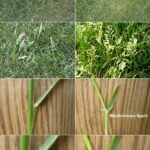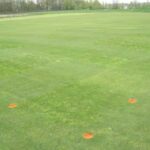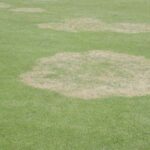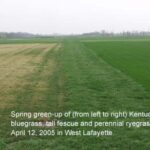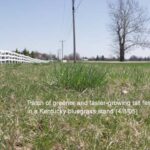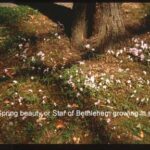Turf Tips Archives
Update on Black Cutworm
Significant weather events from the south usually are responsible for the movement of the black cutworm moths into our area each spring beginning as early as March. Black light traps stationed throughout the state have failed to catch many black cutworms this year to date. This is good news for our industry and may spell […]
Maximizing Lawn Performance Under Drought
As low moisture conditions continue in Indiana and Indianapolis is already requesting volunteer reductions in water use, it is time to start preparing for a potentially serious drought. Generally, turf can survive 5 to 8 weeks of dry conditions without substantial thinning or death. However, poor soils, traffic, excess heat, low mowing and/or scalping, and […]
Interactive Turfgrass Identification Tool now available
After about 9 months of development a concept of mine has finally borne fruit. This week we rolled out the interactive, self-guided, online turfgrass identification tool, located at: http://www.agry.purdue.edu/turf/tool/index.html. Now you can probably identify the mystery grass in your lawn from the comfort of your own computer. If you still can’t identify it, you can always […]
Fertilizing Sports Turf
Fertilizing sports turf is critical in order to maintain turf vigor in spite of intense wear and tear. However, too little fertilizer or poorly timed fertilizer are common mistakes on sports complexes. Following are our recommendations for sports field fertilization: Apply fertilizer just prior to the season to insure aggressive growth Apply60% or […]
Fundraiser Golf Tournament for Don LaPierre
A good friend of the Indiana turf industry, Don LaPierre, has recently been diagnosed with cancer. A fundraiser golf tournament for Don and his family will be held on June 21st at Greenfield Country Club in Greenfield, followed by a live auction. One hundred percent of the proceeds will go to Don and his family. […]
Phosphorus Fertilization in Turf
Phosphorus (P) fertilization of turf is being questioned nationally for two reasons. Phosphorus fertilization almost never induces a visual turfgrass response and deficiency symptoms are rarely seen, thus calling into question the need for P fertilization. Secondly, higher levels of P contribute to algal blooms and decrease water quality of ponds, lakes, and streams. Since […]
Late May is Good Time to Fertilize Lawns
The annual phase of rapid cool-season shoot growth of cool-season grasses is nearly complete, though it was diminished this year because of the dry and cool weather. It’s now time to consider fertilizing your lawn because fertilizer now will not dramatically increase vertical growth as long as moderate nitrogen rates are used and it will […]
Which is it, Annual Bluegrass or Kentucky Bluegrass?
Kentucky bluegrass is currently producing seedheads that are difficult to mow and create an uneven appearance. However, annual bluegrass (Poa annua) is also producing similar looking seedheads. It’s important to distinguish the two because Kentucky bluegrass is highly desirable in a lawn, but annual bluegrass is a weed. It is a weed because it is […]
Annual bluegrass (Poa annua) in Full Bloom in Lawns and Athletic Fields
Annual bluegrass is now very common in lawns and athletic fields, though it has been a problem on golf courses for years. Annual bluegrass is a lighter green than Kentucky bluegrass and perennial ryegrass, and will thin and die during the heat and drought of August in Indiana. It’s especially noticeable now because of it’s […]
Don’t Trust the Tonics You Hear on TV
There’s a number of “tonics” recently extolled on local and national television that include ingredients like shampoo, ammonia, cola (not diet of course), beer (not light beer), hydrogen peroxide, and dish soap among others. Though you may think you see some effect of these products, there is little or no scientific basis for applying these […]
Season-long Grub Control from May Applications???
Grub control products are currently being displayed in the center aisles of retail department and discount stores and are advertised on the radio as providing season-long grub control when applied in early May. Certain insecticides, including imidacloprid (Merit) and halofenozide (Mach 2) do have a very long residual in the soil. However, they should not […]
Bentgrass Species and Cultivar Selection Impacts Annual Bluegrass Invasion in Renovated Bentgrass Fairways
Along with the warmer spring temperatures two things are certain; crabgrass will eventually germinate and annual bluegrass will profusely flower. For anyone managing bentgrass fairways or considering a bentgrass fairway renovation some of our recent research results will be of particular interest and provide some food for thought. There has been some mild interest in […]
Time is Running Out for Preemergence Control of Crabgrass
The below average temperatures the last few days has delayed crabgrass germination and thus premergence annual grass herbicides should still be effective if applied this week in the northern half to 2/3rds of the state. Most of the preemergence herbicides do have some post-emergence properties that will burn back small crabgrass (one or two leaf […]
Watch for Breakthrough from Early Preemergence Herbicide Applications
The extremely dry spring may reduce the effectiveness of preemergence herbicides. The products must be watered-in or rained-in to move them below the canopy and down to the soil where they will be effective. Herbicides not watered-in may also photodegrade faster than those wateredin. Early research showed a 44% loss in three days of preemergence […]
Rhizoctonia Large Patch (Zoysia Patch)
As our zoysiagrass fairways and tees are greening up this spring, we will soon begin to see the symptoms of Rhizoctonia Large Patch (zoysia patch). Rhizoctonia Large Patch (RLP) is the only major disease of zoysiagrass in Indiana. The pathogen is favored by moderate temperatures and long dew periods in the spring, fall and during […]
Slowly Greening Lawns
Many lawns are slow to green-up this year and it is mostly due to the presence of Kentucky bluegrass. Even though Kentucky bluegrass is the best lawn grass for the Midwest, it is much slower than perennial ryegrass and tall fescue to green up in the spring (photo). A little patience, some rain, and some […]
Spring Dandelion Control for Professionals
Many turf areas did not get treated for broadleaf weeds last fall because of the dry weather. Though fall applications are most effective for controlling broadleaf weeds, spring applications are warranted for new lawns or areas that did not get treated last fall. Spring applications will be most effective if you wait until dandelions are […]
Tan Patches in an Otherwise Green Lawn
Tan patches in an otherwise green lawn at this time of the year are likely due to either slow-greening warm-season grasses or snow mold. The most common tan patch right now is warm-season grasses like nimblewill or zoysia (photos). Time, warming temperatures, and rainfall are the cures for most of these patches and they should […]
Dark Green Patches in Otherwise Lighter Green Lawn
Patches of tall fescue or perennial ryegrass are currently much greener than Kentucky bluegrass (photos). Patches of these two grasses are prominent right now as the bluegrass is just starting to green up. Give it another week and the bluegrass will catch up with the tall fescue or ryegrass. No control is needed to remove […]
Star of Bethlehem, Spring Beauty Emerging in Shaded Areas
Star of Bethlehem and Spring Beauty are currently emerging and flowering in shaded areas. Both plants have pretty white flowers with the Star of Bethlehem having six petals while Spring Beauty has only five petals . The Star of Bethlehem was once planted as an ornamental while the Spring Beauty is native. Both plants are […]
